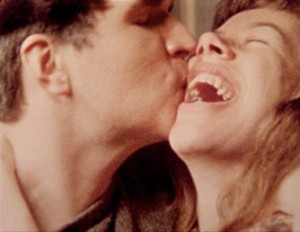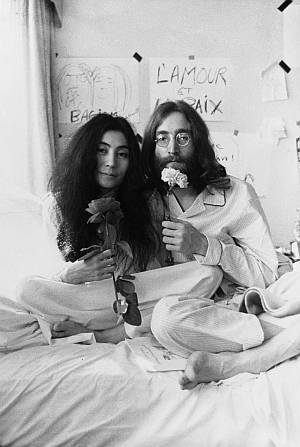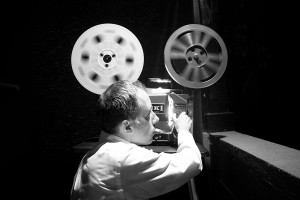by Melanie Crew
Managing Editor
Jane Wodening, first wife to acclaimed experimental filmmaker Stan Brakhage, is a central character in the avant-garde film world. Jane is set to speak about her life in and out of cinema, her collaboration and marriage to Brakhage, as well as her own writing, at the Atlanta Contemporary Art Center on Sat. Feb. 13 at 7 p.m. Included in this event is the screening of three short films focusing on Wodening, all shot in 16mm: WINDOW WATER BABY MOVING (1959 – 12 min/Stan Brakhage); HYMN TO HER (1974 – 2 min./Stan Brakhage); and JANE BRAKHAGE (1975 – 10 min./Barbara Hammer). “Jane Wodening in Person” is hosted by Andy Ditzler [March 2011; see ATLRetro’s Kool Kat feature on Andy here] and Film Love Atlanta. Don’t miss out on this exciting and rare opportunity to delve into the life of Jane Wodening, in her own words.
Wodening’s marriage to Brakhage spanned three decades (1957-1987). Their marriage and family life, including rarely exposed intimate details, is the subject of many of Brakhage’s filmic endeavors. Although Brakhage is considered one of the of “the most important figures of 20th century experimental film,” Wodening’s collaboration with him is noteworthy in itself. She was not merely the subject, or “muse,” but was an active participant in the production of those films. Additionally, Wodening spent the last few decades churning out her own art; her written words (prose poetry, fiction, non-fiction, memoirs, etc.) can be found on her website here [FROM THE BOOK OF LEGENDS (1988); LUMP GULCH TALES (1993); BOOK OF GARGOYLES (1999); LIVING UP THERE (2013); BRAKHAGE’S CHILDHOOD (2015)] and most recently WOLF DICTIONARY (2016), which she will include at Film Love Atlanta’s event.
ATLRetro caught up with Jane Wodening for a quick interview about her life and collaboration with Stan Brakhage, her artistic influences, the importance of the written word and her desire to write the biography of the  Universe.
Universe.
ATLRetro: You were a necessary component in the films of Stan Brakhage, as his wife and “muse.” Did you ever see yourself as something greater than the films themselves, or did you consider yourself a necessary part of the whole that was Stan Brakhage?
Jane Wodening: Naturally, I thought of myself as myself, but I felt that he was saying that I inspired him.
Stan’s films delved deeply into your marriage and family life. Did you ever feel overly exposed to the public? And how did you deal with that exposure?
When we were filming, we were alone. When the films were made and shown and people would ask me that, I’d say, well, that was then, and this is now. What I am is here before you, and I’m not those images.
Can you tell our readers about the roles you played in Brakhage’s films? Meaning, we see you onscreen, but did you assist in the techniques used? Did you work with Stan behind the scenes, preparing the films?
Yes. They were his films, always, but I did a lot. The world he photographed was my world; the children were under my guidance. Sometimes I’d run the camera, help him with editing, change things. We always discussed it if I did. Once or twice, I was the Sound Man. He said many times that “by Brakhage” meant by me also, AND the kids, and there was some truth in that. I was surely devoted to him and his work.

Stan, Jane – Still from WINDOW WATER BABY MOVING (1959)
What are your thoughts on WINDOW WATER BABY MOVING? Were you supportive of Stan filming the birth of your first child? Looking back, what do you feel now that maybe you didn’t feel then?
I was agreeable to it. We were in this together. This was our life and he was a film artist. Naturally, he would want to film the birth. He filmed every birth. I liked having him there with me.
There must be an interesting story about how you and Stan met. Can you fill our readers in on your meeting?
I saw him twice before we met. The first time, I was coming out of the opera house with my date. We had gone to the matinee, and there on the street were two guys dueling. My date said, “Yes, they have a very off-beat little theatre in a tent.” But we didn’t have time to go to it. The duelists were Stan and Larry Jordan. The second time I was working across the street from Rockefeller Center in New York and I’d go to the Rockefeller Plaza to eat my sack lunch. When it rained I went into the mall where I found a Brentano’s Bookstore and bought books from him, but he would not look at me.
The third time was when I was introduced to him. He was renting a little house in Denver and my boyfriend at the time introduced me to him, said he was a genius. He started teaching a class unofficially with the film club, and my cousin Betsy and I sat in the back row giggling about “The Great Brakhage” because he seemed to be presenting himself that way. But one moment we stood together under a tree and fell in love. I was amazed when he didn’t contact me. He was with another girl who knew me, and finally said to him, “I think Jane Likes you.” By this time I was horribly depressed  and sent him a letter, so he called me up and said he loved me and to come and visit him. It was about six weeks later that we married.
and sent him a letter, so he called me up and said he loved me and to come and visit him. It was about six weeks later that we married.
The ‘50s and ‘60s were a time filled with art and stories and experimentation in all forms. Can you tell our readers a little about your and Stan’s life in art before your children were born?
I entered the scene in 1957, and while the children were being born, we traveled a lot and met and befriended as many of the artists in all fields as we could. It was a very lively scene. We were all gods. We were very poor and we were going to change the world. We all knew each other, were drawn to each other like magnets, and we all agreed. It was exhilarating. And we did change the world.
We see that your most recent book, BRAKHAGE’S CHILDHOOD, is a retelling of Stan’s Depression-era childhood, as told to you in the ‘80s in conversations with Stan. In what ways do you think Stan’s formative years affected his art, his career, his family?
He was born a precocious child. He loved to get attention and he loved theatre. As a child, he put on shows, sang in the church, whatever. He had a rough childhood, pillar to post. He never outgrew being the center of the world.
Can you tell us a little about your most recent book, WOLF DICTIONARY?
I have it here. As a child, I ran with dogs, learned what they were communicating. I’ve always thought I learned dog  language first and English as a second language. In my early 20s, I wanted to write a dog dictionary. Years later, three people told me about the time when they lived “way up the road beyond where the snowplow went across a winter and they watched a wolf and his mates.” I was very charmed by this story, but couldn’t figure how to present it. I finally realized that I could write it from the viewpoint of the wolf. But even then, people would read it and still they wouldn’t learn the language. So I added notes, talked about why the animal made that gesture, what it meant. To me it seemed obvious as pie. So that’s WOLF DICTIONARY. It’s a key to start understanding animals and what they are communicating.
language first and English as a second language. In my early 20s, I wanted to write a dog dictionary. Years later, three people told me about the time when they lived “way up the road beyond where the snowplow went across a winter and they watched a wolf and his mates.” I was very charmed by this story, but couldn’t figure how to present it. I finally realized that I could write it from the viewpoint of the wolf. But even then, people would read it and still they wouldn’t learn the language. So I added notes, talked about why the animal made that gesture, what it meant. To me it seemed obvious as pie. So that’s WOLF DICTIONARY. It’s a key to start understanding animals and what they are communicating.
How has your writing evolved over the years? Has there been a change in subject-matter? Tone? In your youth did you feel the need to express ideas that you don’t quite feel the need to express now?
In fact, I didn’t start writing until I was nearly 40, but even then, across the last 40 years, I have changed a lot in my writing. I never was interested in writing fiction. I always wanted to write to understand something that came to my attention. At first, I felt obliged to write a story with a beginning, a middle and an end, but then I got really excited about the realism of form that anecdote gave. Now I feel that biography can get to understanding the life if the motives and drives are shown and develop into acts and responses and perspectives. I’m now considering writing the biography of the earth, to clarify the legend that the scientists are excited about. It will be a sort of translation. I’m hoping I can show it as adventures.
 Which writers (poets, novelists, etc.) influenced you the most?
Which writers (poets, novelists, etc.) influenced you the most?
I think my first big influence was Rembrandt who looks at me through his eyes and we look at each other. He tells me to work, to pour out vitality. Gertrude Stein is reassuring. She tells me it’s perfectly okay to be an odd-ball. Henry James tells me it’s all right to talk at great length about little details; just dance it, and I’ll have it right. Poe shows me how to put rhythm into my writing, to write the percussion and the beat. Vivaldi says to make living landscapes with whatever media. My father taught me to be blown away by a squirrel or an anthill or a bush.
With regards to filmmaking and art, who were your and Stan’s biggest influences?
I think I was his and he was mine.
Are there any filmmakers today (experimental and/or narrative) that you find intriguing?
Ken Jacobs, Ernie Gehr, Nathaniel Dorsky, all close to my age. I wonder if there are any young people doing art? I know there’s much that has been done in comic format. Rap seems full of energy, but it seems hard to avoid selling a message. I don’t know. It may be an in-between time, or possibly I’m unaware of what’s going on with the young. There is always talent, and talent is a beautiful thing, no matter what one does with it, but great periods like Baroque music or the Impressionists seem to be the blooming times.
What is your take on compartmentalizing art and films into genres? Do you think these types of creative outlets can be properly tucked away into a single box? Or do you think most art (including film) overlaps several different genres?
be properly tucked away into a single box? Or do you think most art (including film) overlaps several different genres?
When I tried to get agents or publishers to publish me, they’d say, but what is your genre? Evidently, if you’re writing in a genre, you know what you have to do and you get published. This doesn’t interest me. I write what I write.
Can you offer any advice to our readers about film, personal expression and creativity?
Whatever you do you’ll do what you’re told. The question is, who do you want to listen to? – The shop boss? There’s a steady job. – The pulse of the culture? – If you do that, you might starve and/or become famous. How about that inner voice? – How about writing what you want to know? – That’s where I’m at – I write to think.
What’s next for Jane Wodening?
I want to write the biography of the earth. There is some possibility that it will be the biography of the Universe. I’d like to put it all into common English, so anyone could know at least the theory of the moment – the amazing adventures of this planet and the life on it. I have a mess of little pieces of writing I’d like to put into shape – animal biographies, other thoughts. I really enjoy thinking. There’s nothing more fun than thinking.
Can you tell our readers what they can expect at Film Love Atlanta’s event, “Jane Wodening in Person,” on February 13?
 They can expect to be surprised about a number of things.
They can expect to be surprised about a number of things.
We know you’ve done plenty of interviews, but is there something you’d like to tell our readers that they don’t know already?
I’m not sure what to say to this. I’m hoping they have open minds.
Photos courtesy of Jane Wodening and used with permission.





